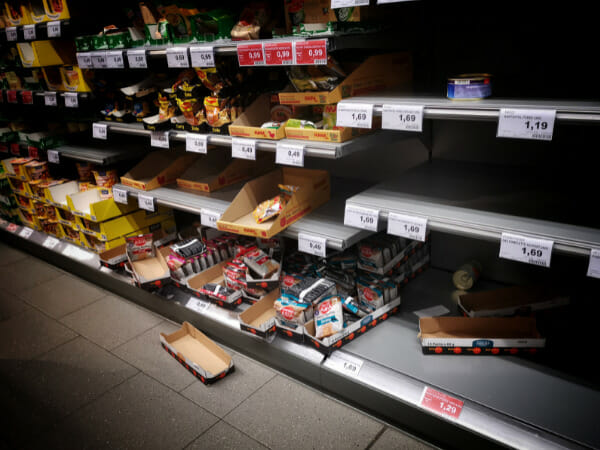Supply chain disruption – how COVID-19 hit economies
The coronavirus pandemic brought supply chain disruptions that are now showing around the world. Businesses are struggling to procure raw materials for their products, so they will have difficulty providing supply even as demand continues to grow. With low supply and high demand, everyone will see prices soar higher in the future.
This doesn’t mean that businesses and individuals cannot do anything about it. Companies will have to adopt new ways of doing business if they want to survive or even thrive. Meanwhile, regular folk should prepare their finances and stock up on basic needs. We will take a long time to get the global economy back on its feet, but we could do it!
Let’s start by going deeper into how the worldwide supply chain disruption came about. Then, we will explain how businesses can adapt to these changes. After that, we will explain how regular people can prepare for its effects. If you’re planning to apply these tips, you must make sure you do it as soon as you can because sudden shifts may happen at any time.
The end of the economic downturn brought by COVID-19

Our globalized world depends on trade among countries. Many of the stuff you purchase nowadays come from overseas. If not, they’re likely made of materials from those regions.
All that stuff comes from huge ships with hundreds of containers in them. When the coronavirus appeared, countries responded by keeping people in their homes.
Businesses couldn’t operate, so millions of people lost their jobs. In turn, people quickly ran out of money. Overall, these effects slowed down economies around the world.
Fortunately, the global economic recovery continues to gather steam, specifically in the United States. A statement from the White House reported that people are buying more.
What’s more, people are buying more homes and cars, which caused home and auto sales to reach their highest level in more than a decade. However, this isn’t the end of the economic woes.
The start of a worldwide supply chain disruption
The lockdowns had a lasting impact on our economy. For example, various industries became smaller during the pandemic due to so many job losses.
Many businesses couldn’t reopen as they’ve been struggling to hire workers. This caused a record of 8.3 million job vacancies. Still, people don’t want to fill them!
The sectors that are hiring mostly offer trades jobs. Sadly, people often look down on these roles. Yet, many of them pay the same if not more than jobs that need college degrees.
Specifically, there’s a shortage of truck drivers in the US and the UK. Many of them are about to retire, yet these countries have not found new workers to replace them.
This makes it harder for stores to have enough goods and avoid running out of stock. As a result, the supply for everything can’t meet the growing demand.
Following the Law of Supply and Demand, we should expect higher prices for consumer goods, such as computer chips, making it harder for people to buy things.
If people don’t start spending soon enough, the businesses selling these goods may go out of business. Global economic recovery continues, but it’s stymied by supply chain bottlenecks.
Read More: What Are The Effects Of The Global Chip Shortage?
How can businesses deal with it?
Governments are looking to fix supply chain issues. For example, US President Joe Biden said the port of Los Angeles will work 24/7 to avoid problems during the holidays.
Businesses shouldn’t just wait for these solutions to work, though.
If you have a company, you can prepare for the supply chain disruptions with the following tips:
- Look for weaknesses – Sooner or later, you will run out of supplies. The question is, which points of your supply chain are likely to go first? Identify those, and then see if you need to replace them with more reliable ones.
- Have a plan – Once your supply lines are cut, you’ll have to know what to do and execute quickly. For example, make sure you inform customers and suppliers about potential delays with early phone calls or press releases.
- Budget – You’ll need money to do all these steps, so make sure you have enough money for it. This will make sure money won’t get in the way if you need to respond to shortages.
- Have multiple suppliers – Aside from replacing suppliers, you might want to have backups just in case. If your main goes out, the others could take its place.
- Stockpile supplies – You may want to store extra materials. As we said, you’ll have to spend money to keep backups yourself since you may need more storage space. This may not work if you use materials that spoil or expire after a while.
Most importantly, you need to invest in technology. The world is going through a digital transformation in part because of the global supply chain disruption.
These will allow you to gather real-time market data, so you can quickly respond to sudden changes. Others will help your business run better than ever.
Thankfully, even small businesses can get these tools that can help them keep up. You may check the best ones by clicking here.
How should I respond to this supply chain disruption?
We’ve given tips for businesses, but how about regular folks like you and the other readers? You can prepare for these changes too with these steps:
- Plan your finances – Check your money situation by laying out all the things you buy every day. Then, separate the needs from the wants and determine your take-home pay.
- Spend less – Compare your expenses and your funds to see which “wants” you need to reduce or remove. This will help you have money for your needs and debts.
- Earn more – You might want to get a side gig on top of your current one. That way, you can earn money outside work hours.
- Pay off debts – The previous tips should have provided more money towards debt payoff. Get rid of them as soon as you can, so your money goes to your needs and wants only.
- Build an emergency fund – You have to set aside extra cash in case something goes down. If prices go up again due to supply chain disruptions, that fund can help you make ends meet. What’s more, you’re less likely to borrow money.
Related Articles
Final thoughts
Businesses will have to spend money and effort to adjust to the supply chain disruptions. Yet, they must because it’s not the only change we may see soon.
After all, nobody ever saw the COVID-19 pandemic coming. Otherwise, we would have all been prepared to deal with it. That’s why adaptability should be the number one priority for everyone.
You can adapt by learning more about what’s happening in the world. Fortunately, Inquirer USA articles can provide the latest update on the hottest trends.




